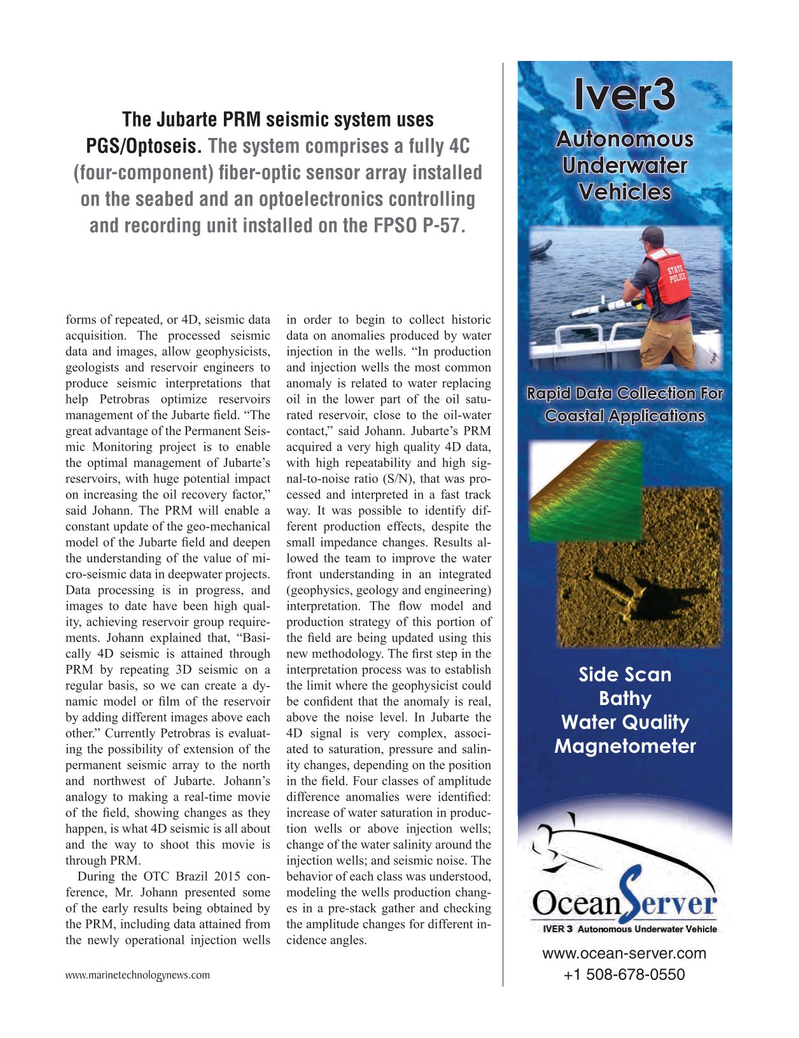
Page 55: of Marine Technology Magazine (March 2016)
Oceanographic Instrumentation: Measurement, Process & Analysis
Read this page in Pdf, Flash or Html5 edition of March 2016 Marine Technology Magazine
Iver3
The Jubarte PRM seismic system uses
Autonomous
PGS/Optoseis. The system comprises a fully 4C
Underwater (four-component) ? ber-optic sensor array installed
Vehicles on the seabed and an optoelectronics controlling and recording unit installed on the FPSO P-57. forms of repeated, or 4D, seismic data in order to begin to collect historic acquisition. The processed seismic data on anomalies produced by water data and images, allow geophysicists, injection in the wells. “In production geologists and reservoir engineers to and injection wells the most common produce seismic interpretations that anomaly is related to water replacing
Rapid Data Collection For help Petrobras optimize reservoirs oil in the lower part of the oil satu- management of the Jubarte ? eld. “The rated reservoir, close to the oil-water
Coastal Applications great advantage of the Permanent Seis- contact,” said Johann. Jubarte’s PRM mic Monitoring project is to enable acquired a very high quality 4D data, the optimal management of Jubarte’s with high repeatability and high sig- reservoirs, with huge potential impact nal-to-noise ratio (S/N), that was pro- on increasing the oil recovery factor,” cessed and interpreted in a fast track said Johann. The PRM will enable a way. It was possible to identify dif- constant update of the geo-mechanical ferent production effects, despite the model of the Jubarte ? eld and deepen small impedance changes. Results al- the understanding of the value of mi- lowed the team to improve the water cro-seismic data in deepwater projects. front understanding in an integrated
Data processing is in progress, and (geophysics, geology and engineering) images to date have been high qual- interpretation. The ? ow model and ity, achieving reservoir group require- production strategy of this portion of ments. Johann explained that, “Basi- the ? eld are being updated using this cally 4D seismic is attained through new methodology. The ? rst step in the
PRM by repeating 3D seismic on a interpretation process was to establish
Side Scan regular basis, so we can create a dy- the limit where the geophysicist could
Bathy namic model or ? lm of the reservoir be con? dent that the anomaly is real, by adding different images above each above the noise level. In Jubarte the
Water Quality other.” Currently Petrobras is evaluat- 4D signal is very complex, associ-
Magnetometer ing the possibility of extension of the ated to saturation, pressure and salin- permanent seismic array to the north ity changes, depending on the position and northwest of Jubarte. Johann’s in the ? eld. Four classes of amplitude analogy to making a real-time movie difference anomalies were identi? ed: of the ? eld, showing changes as they increase of water saturation in produc- happen, is what 4D seismic is all about tion wells or above injection wells; and the way to shoot this movie is change of the water salinity around the through PRM. injection wells; and seismic noise. The
During the OTC Brazil 2015 con- behavior of each class was understood, ference, Mr. Johann presented some modeling the wells production chang- of the early results being obtained by es in a pre-stack gather and checking the PRM, including data attained from the amplitude changes for different in- the newly operational injection wells cidence angles. www.ocean-server.com www.marinetechnologynews.com +1 508-678-0550
MTR #2 (50-65).indd 55 2/19/2016 5:08:21 PM

 54
54

 56
56
